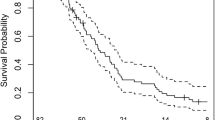Abstract
Recently, there has been greater awareness that combination radiation and temozolomide used to treat glioblastomas may cause increased contrast enhancement on the first post radiation MRI scan. However, this increased enhancement may stabilize or decrease over time and represent pseudo-progression (psPD) rather than true progressive disease. It has never been shown that this phenomenon is greater with combination therapy than radiation alone. To address this question, we reviewed MRI scans in glioblastoma patients treated with radiation alone versus patients treated with radiation and concomitant temozolomide and compared the frequency of psPD in the two groups. Eighteen of 47 patients (38%) treated with radiation alone demonstrated enlargement on their first post-radiation MRI scan and 11 of these 18 (61%) proved to have psPD as defined by no further enlargement on stable therapy for 3 months following radiation. Twenty-four of 45 patients (53%) treated with radiation and temozolomide had enlargement on their first post-radiation MRI scan and 13 of these 24 (54%) had psPD. Median overall survival (OS) in patients with psPD treated with radiation alone was 15.6 versus 12.8 months in those without psPD. Median OS in patients treated with radiation and concomitant temozolomide who had psPD was 24.4 versus 15.9 months in those who did not have psPD. We were unable to detect a difference in OS between the four groups. Presence of psPD, independent of treatment, was associated with prolonged progression-free survival (P = 0.05) but not OS. psPD may be more common in combination therapy but most likely by a small margin.



Similar content being viewed by others
References
Stupp R, Mason WP, van den Bent MJ et al (2005) Radiotherapy plus concomitant and adjuvant temozolomide for glioblastoma. N Engl J Med 352:987–996. doi:10.1056/NEJMoa043330
Chakravarti A, Erkkinen MG, Nestler U et al (2006) Temozolomide-mediated radiation enhancement in glioblastoma: a report on underlying mechanisms. Clin Cancer Res 12:4738–4746. doi:10.1158/1078-0432.CCR-06-0596
Wedge S, Porteous J, Glaser M, Marcus K, Newlands E (1997) In vitro evaluation of temozolomide combined with X-irradiation. Anticancer Drugs 8:92–97. doi:10.1097/00001813-199701000-00013
van Rijn J, Heimans J, van den Berg J, van der Valk P, Slotman B (2000) Survival of human glioma cells treated with various combination of temozolomide and X-rays. Int J Radiat Oncol Biol Phys 47:779–784. doi:10.1016/S0360-3016(99)00539-8
Taal W, Brandsma D, de Bruin HG, Bromberg JE, Swaak-Kragten AT, van den Bent MJ (2008) The incidence of pseudo-progression in a cohort of malignant glioma patients treated with chemo-radiation with temozolomide. Cancer 15:405–410. doi:10.1002/cncr.23562
Brandsma D, Stalpers L, Taal W, Sminia P, van den Bent MJ (2008) Clinical features, mechanisms, and management of pseudoprogression in malignant gliomas. Lancet Oncol 9:453–461. doi:10.1016/S1470-2045(08)70125-6
Brandes AA, Franceschi E, Tosoni A et al (2008) MGMT promoter methylation status can predict the incidence and outcome of pseudoprogression after concomitant radiochemotherapy in newly diagnosed glioblastoma patients. J Clin Oncol 26:2192–2197. doi:10.1200/JCO.2007.14.8163
Macdonald DR, Cascino TL, Schold SC, Cairncross J (1990) Response criteria for phase II studies of supratentorial malignant glioma. J Clin Oncol 8:1277–1280
Kumar AJ, Leeds NE, Fuller GN, Van Tassel P, Maor MH, Sawaya RE, Levin VA (2000) Malignant gliomas: MR imaging spectrum of radiation therapy- and chemotherapy-induced necrosis of the brain after treatment. Radiology 217:377–384
de Wit MC, de Bruin HG, Eijkenboom W, Sillevis Smitt PA, van den Bent MJ (2004) Immediate post-radiotherapy changes in malignant glioma can mimic tumor progression. Neurology 63:535–537
Barker F, Prados M, Chang S et al (1996) Radiation response and survival time in patients with glioblastoma multiforme. J Neurosurg 84:442–448
Chamberlain MC, Glantz MJ, Chalmers L, Van Horn A, Sloan AE (2007) Early necrosis following concurrent Temodar and radiotherapy in patients with glioblastoma. J Neurooncol 82:81–83. doi:10.1007/s11060-006-9241-y
Author information
Authors and Affiliations
Corresponding author
Rights and permissions
About this article
Cite this article
Gerstner, E.R., McNamara, M.B., Norden, A.D. et al. Effect of adding temozolomide to radiation therapy on the incidence of pseudo-progression. J Neurooncol 94, 97–101 (2009). https://doi.org/10.1007/s11060-009-9809-4
Received:
Accepted:
Published:
Issue Date:
DOI: https://doi.org/10.1007/s11060-009-9809-4




